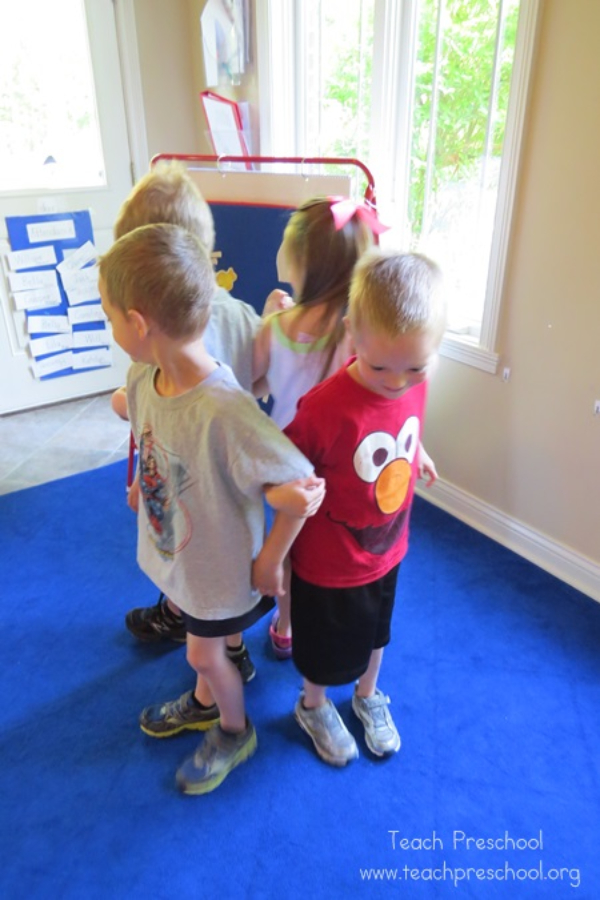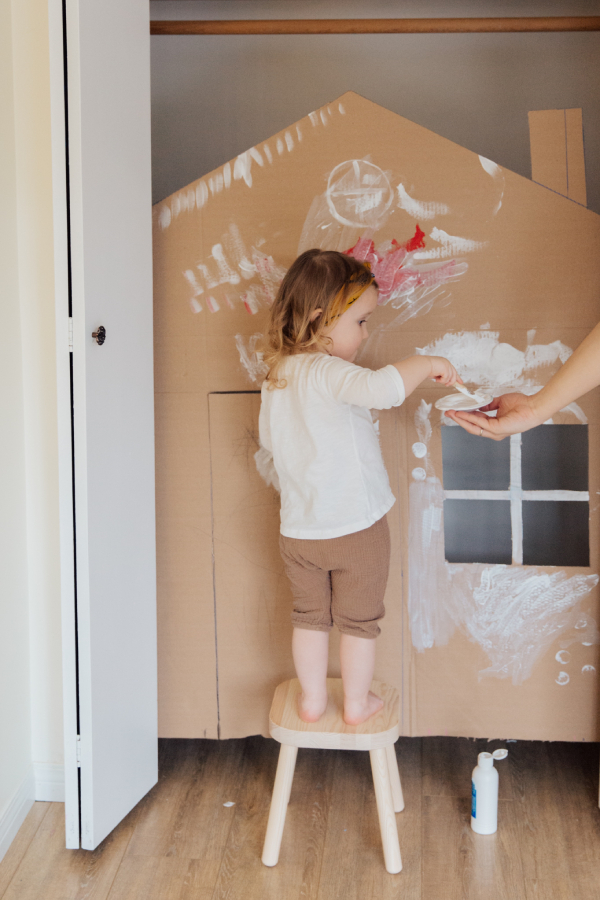settings
children
With Famly since
Cooperative play lays the foundation for children’s relationships, and frames their long-term social development. When children practice cooperative play, they learn how to handle conflicts, to compromise, and regulate their emotions.
Beyond that, cooperative play also teaches children how to collaborate with others towards a common goal, how to communicate their desired outcomes, how to negotiate, follow rules, and to assign and accept responsibility with one another.
In short, cooperative play helps children learn to get along with others.
But how do you foster cooperative play in your early years setting? One of the best ways is through fun play activities that inspire teamwork.
With that in mind, here are 8 easy cooperative play ideas you’ll want to try to encourage children to collaborate and play together.
1. Blindfolded guided obstacle course
The cooperative play idea: whatdoesmammasay.com
What it’s about: By helping a blindfolded partner navigate a simple obstacle course, children learn to give directions to one another, and hone their communications skills. They’re encouraged to express their needs to others, and they learn to listen to their teammates' directions and work together toward the common goal, each one playing his/her distinct role in this

What you’ll need:
- A scarf for blindfolding
- Anything you can find around your early years setting to improvise some little obstacles they’ll need to avoid, like little toys, bins, boxes, tape outlines, or pillows.
How you can do it:
First, set up a simple obstacle course in your play space — this could be simple tape outlines to form a path, or perhaps a few piles of bins and blankets scattered around. Make sure to start simple, and match your childrens’ levels of development. Then, decide on pairs of children, one blindfolded and the other one guiding their partner along your obstacle course. Explain the concept, and let the teamwork relays begin!
2. Story go-round
The cooperative play idea: handprints.sk
What it’s about: Here’s a fun way for children to practice turn-taking, storytelling, and cooperation: by making up a story together, word by word. As you build your story, you learn to follow others’ examples, and build on one another's’ ideas, all while flexing your creative muscles.

What you’ll need:
- A place to sit together (this can easily be done outdoors)
- A fun introduction prompt for the story they’ll be creating (e.g. “A hamster and a guinea pig went on a picnic in the park.”).
How to do it:
Start the story with your introductory line, and let the children take it from there: “There, they saw a squirrel and invited her to join them... But when they opened their picnic basket, the hamster and the guinea pig realized they forgot to take the peanut butter... Then, the squirrel told them that she’ll give them some of her own peanuts...” One by one they’ll each have to add a phrase to the story that they’ll all be “writing”, on the go, cooperatively. You can decide whether you’d like to add one word at a time, or sentence by sentence.
3. Team puzzle time
The cooperative play idea: Building Blocks Speech, Language & Literacy

What it’s about: By encouraging children to work together to complete a puzzle, you encourage them to cooperate during play. It’s a simple, familiar, and time-tested way toward cooperative play.
What you’ll need:
- A large floor puzzle, appropriate for your childrens’ age and developmental level
How to do it: Set out your puzzle (or puzzles) in your play space, and let your children run wild — encouraging them to find partners, or approach the puzzle in groups. If you like, you could put on some favorite songs, and challenge the children to work together to put their puzzles together before you get through your playlist.
4. Hula hoop pass
The cooperative play idea: WeAreTeachers.comWhat it’s about: Children hold hands in a circle, and try to pass a hula hoop all the way around. This challenges children to practice their communication and coordination, and motor skills to strategize on how they can work together towards their common goal.

What you’ll need:
- A hula hoop
- Open play space (ideal for outdoors)
How to do it: Have your children stand in a circle. Place the hula hoop on one of the child’s arms and ask them to join hands with the two children next to them.. Then, ask all the children to hold hands and close the circle. Next, tell them to try and move the hula hoop all the way around — the challenge here is for them is to reach their common goal without letting go of their hands.
Tip! At the beginning of this cooperative play activity, put the hula hoop on one of your shoulders and across the front of your body. Demonstrate how they’ll need to pass it from one to the other without letting go of their hands.
5. Building the tallest tower
The cooperative play idea: momjunction.com

What it’s about: The activity challenges children to practice their creative thinking: they need to get inventive about what they’ll use to make their tower the tallest — all while encouraging one another to communicate their ideas, explore together and cooperate to build their tower.
What you’ll need:
- A table to use a building surface
- Blocks, books, cups, or any other stackable material you can use for your tower
How to do it: Gather your children into groups, and take a minute to explain the concept for everybody. You might want to build an example tower, just to show how it’s done. Like with the puzzle activities above, you can set this to music to add a bit of extra fun, or a set time limit.
6. Exploring as an eight-legged octopus
The cooperative play idea: Teach Preschool

What it’s about: Children link up to form an eight-legged octopus, and learn to communicate and move together so that they can explore new spaces in their fun eight-legged form.
What you’ll need:
- The book “My Very Own Octopus” by Bernard Most
- An open space in which to move about
How to do it:
Start by reading your children the story, then ask them whether they’d like to be octopus themselves too. Then, highlight the idea in the book: that it’s so cool for an octopus to have 8 legs. It gets to do so many things simultaneously! Then challenge them with the idea that they, too, could have 8 legs. Once you sell the idea to your children, tell them it’s time to become octopi. Group them into teams of four and have them sit back to back on the floor, hook their arms and work cooperatively to stand up and walk like that. Lots of giggles guaranteed!
7. Create a big mural together
The cooperative play idea: Teach Preschool

How it helps: Painting a mural encourages children to practice the three C’s critical in their cooperative play development stage: communication, cooperation, and coordination. It also focuses on creative thinking, motor skills and sharing ideas.
What you’ll need:
- Crayons or paintbrushes, paint sticks, markers or chalk
- A large sheet of paper, a canvas or a sidewalk
- Maybe some college materials to add to your collaborative art piece
How to do it:
The idea is simple: let children unleash their creativity through painting, but encourage them to see their little work as a collaborative project. This way, they’re more motivated to communicate with one another about the spots that still need coloring, about the style of coloring they should choose.
8. The classic parachute
Image source: https://www.extendednotes.com/ The cooperative play idea: Edutopia

How it helps: By manipulating a big piece of fabric together, your children learn how to coordinate their movements with the actions of the others in their group.
What you’ll need:
- A large piece of fabric, ideally a colorful classroom parachute
- A soft foam ball, or stuffed animal
How to do it: Ask the children to stand around the edges of the parachute and place a ball (or stuffed animal) in the center. Then, have them move back and stretch the fabric, so that they launch the ball upward. The cooperative play challenge for them here is to collaborate to launch and catch the ball with the parachute over and over again, making sure it doesn’t fall off. Teamwork (and lots of laughter) at its best!
The big ideas
Please note: here at Famly we love sharing creative activities for you to try with the children at your setting, but you know them best. Take the time to consider adaptions you might need to make so these activities are accessible and developmentally appropriate for the children you work with. Just as you ordinarily would, conduct risk assessments for your children and your setting before undertaking new activities, and ensure you and your staff are following your own health and safety guidelines.
Try learning journals for free
Add observations, and build digital learning journals to share with families instantly. All with your completely free 14-day trial.
Get started









